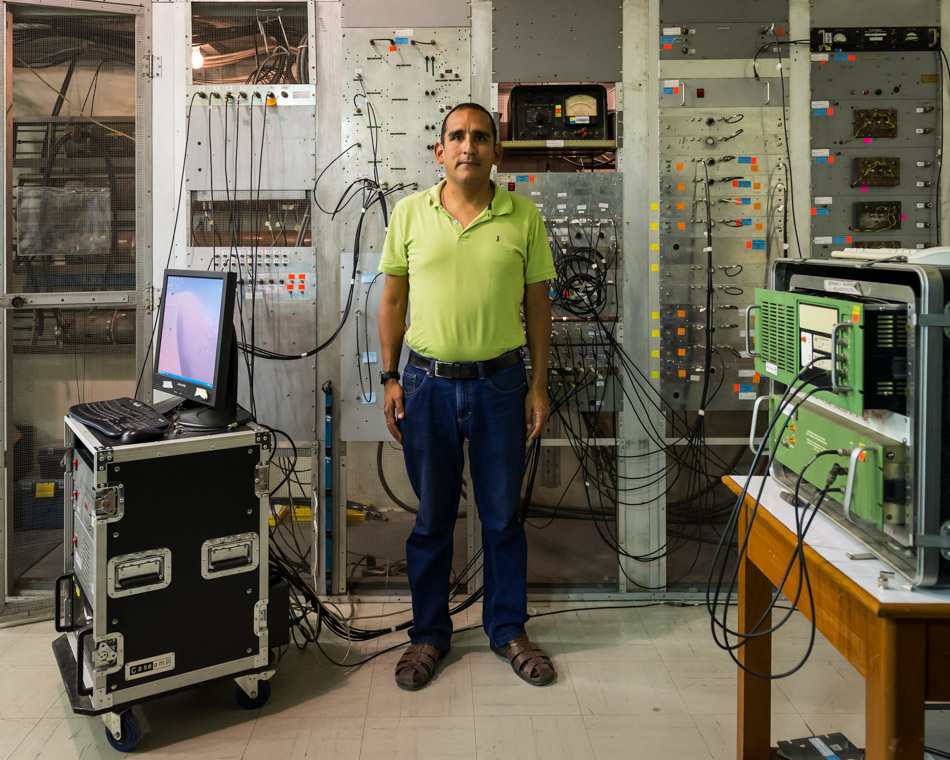"I had never been to Peru before and knew no Spanish. None of us "Gringos" knew much Spanish" says Dr. Donald Farley, ionospheric physicist and alumnus of Cornell, who arrived at the Jicamarco Observatory in 1962. Having finished his PhD a couple of years before and carried out post-docs in Cambridge and Gothenburg, Farley was approached by the founder of the observatory, Dr. Ken Bowles, and asked if he wanted to join the operation in Peru. "I thought "why not" and off I went with my wife Jennie and two daughters Claire, almost 3, and Anne, about 6 weeks old. I was not the first arrival, but I was a very early arrival, and the first theorist. When I arrived the antenna was about half finished and I could watch it being finished, row by row marching towards my office window. There was definitely a feeling of excitement, and we were constantly confronting new problems. We were certainly pioneers."
"Jicamarca is the most important instrument in the world dedicated to the study of the equatorial ionosphere" says Dr. Marco Milla, the current director of the observatory. "Most of what is known in the scientific world about the upper atmosphere in the equatorial region is due to Jicamarca measurements." Situated in the foothills of the Andes, about an hour and a half from Lima, the main antenna at the Jicamarca Radio Observatory (JRO) is the largest incoherent scatter radar in the world, consisting of a 300m x 300m square array composed of 18,432 cross-polarized dipoles. Constructed between 1960-62, the location was chosen due to it's placement on the equator, proximity to the US, temperate year round climate and the surrounding hills which help to shield the antenna from radio signals coming in at low angles. The radar is used to study the ionosphere, a region of the upper atmosphere ranging from about 85km - 600km in altitude, where the molecules are ionized by solar radiation (meaning they acquire a negative or positive charge by gaining or losing electrons).
Victor Quesada Reyes, 56, from Sihuas. Radar operator, has worked at the observatory for 27 years.
Understanding what is going on in the ionosphere is practically important because changes in it's behavior can influence radio and satellite communications. The radar can measure electron density, ion and electron temperatures, ion composition and plasma velocity, and is used to give scientists that understand what those things mean an insight into what is happening in the upper atmosphere. I'm getting a bit out of my depth here, so I'll let Dr. Farley continue: "At first we were just eager to measure the electron density profile (electron density vs altitude and time), but then we also developed ways to measure the electron and ion densities and temperatures (which were often different) and the electron drift velocities. We also studied airglow of various lines (chemical reactions) and variations of the magnetic field (magnetic "storms" due to eruptions on the sun). We also developed interferometric techniques for studying some of the the ionospheric dynamics in detail. Another example is that we measured electron densities to altitudes above 5000 km." Besides studying the ionosphere, the telescope has also been used to study the sun, the planets and the surface of the moon.
Still with me? Good! If not, check out this amazing video from 1963 about building the observatory - even if you don't care about the observatory, it is an amazing example of early 60's kitsch science filmmaking.
Dr. Donald Farley stayed at JRO for 6 years, taking over as director after Dr. Bowles left, and lived through flash floods cutting the observatory off from the outside world, robbers being put down wells to stop them escaping, technicians getting electrocuted with 5000 volts, and a fire starting an hour before a total solar eclipse (something that only happens every couple of hundred years). "The antenna and buildings look pretty much the same as they did in the 1960s, although the antenna is not as shiny as it once was" he says. For many years Dr. Farley continued to visit the observatory every year to do new experiments, and his last visit was at the 50th anniversary reunion in 2012. "I may or may not make another visit, since I just had my 80th birthday a few months ago! But I'm still pretty healthy, so who knows?"
See the website of the observatory for more info: http://jro.igp.gob.pe
Dr. Marco A. Milla, 39, from Lima. Director of the observatory, has worked there for 9 years.
Francisco M. Buendia, 63, from Cerro de Pasco. Network technical support, has worked at the observatory for 43 years.
Ramiro Yanque Robles, 42, form Lima. Head of Opearations Area, has worked at the observatory for 15 years.
Alexander Valdez Portocarrero, 24, from Lima. Project development (IDI), has worked at the observatory for 2 years.
Miguel Urco Cordero, 30, from Juaja. Hardware and software development, has worked at the observatory for 4 years.
Edson Ticona Zegarra, 25, from Arequipa. Works with the cluster for large processing. Has worked at the observatory for 4 months.
Fernando Villanueva Ruiz, 63, from Lima. Designer of electronic circuits, has worked at the observatory for 44 years.
Shermely Moyna, 26, from Cusco. Science communication, has worked at the observatory for 16 months.
Darwin Neil C´rodva Vivas, 45, from Lima. Electrical engineering, has worked at the observatory for 18 years.
Lee Felipe Meza Córdova, 22, from Lima. Technician, has worked at the observatory for 6 months.

















